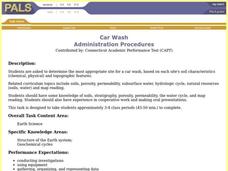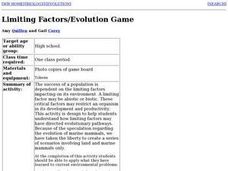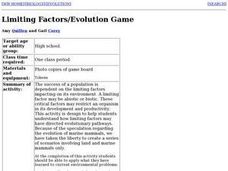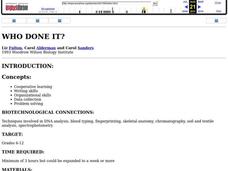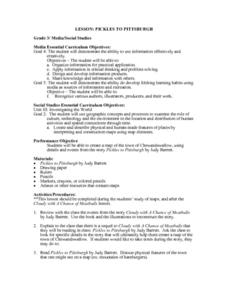Curated OER
Car Wash
Learners determine the most appropriate site for a car wash, based on each site's soil characteristics (chemical, physical) and topographic features. They perform an experiment to determine the changes to three different soil types when...
Curated OER
That's the Way the Ball Bounces
Students investigate and compare the bouncing ability of the materials from which four different balls are made. They determine which material performs the best for use as a basketball. After collecting data in a small group they...
Curated OER
Coat Caper
Students examine pollen and fibers taken from a garment. They analyze pollen from new hybrids and compare it to the samples from the garment then make individual conclusions concerning the specific historical authenticity of the garment.
Curated OER
Poetry Creations
Students produce iMovies to share their thoughts of friendship along with poetry creations in this technology-based lesson plan for the upper-elementary classroom. The lesson plan includes a link to a "create a poem" site and requires...
Curated OER
Color Scheme Design
High schoolers create a work of art using specific color scheme guidelines studied previously. State standards for the arts are addressed in this six day lesson for the high school art class.
Curated OER
How Can Librarians Work To Eliminate Cultural Bias In The Organization Of Information?
Students explore the complexities of organizing information and to support librarians in developing strategies for reducing cultural bias. Students extend strategies to help raise solutions. Students list a variety of definitions on bias...
Curated OER
Civil Rights and the Michigan Supreme Court II
Students view a PowerPoint presentation on the Michigan Supreme Court Historical Society's Civil Rights and/or the Native American Rights. They write a reaction paper and prepare for a class discussion. They work in groups and discuss...
Curated OER
Science and Government: Unholy Alliance or Millennial Bliss?
Pupils participate in a class discussion about scientific developments since 1945. They discuss the risks to the world that stem from these developments and whose responsibility it is to determine the future direction of scientific...
Curated OER
Comparing Fairy Tales
Students read and review common fairy tales and come up with a list of characteristics from them. The Teacher models filling out either a compare & contrast graphic organizer comparing two fairy tales.
Curated OER
Big Magic Squares
Students discover that magic squares are interesting objects in both mathematics proper and in recreational mathematics. So they are objects that students should have heard about and experienced.
Curated OER
Negative Magic Squares
Magic squares are interesting objects in both mathematics proper and in recreational mathematics. So they are objects that children should have heard about and experienced. The problems in this sequence give students the opportunity to...
Curated OER
Antifreeze - Anti Fish
Pupils participate in the production of a play that highlights the direct linkage between storm drains and natural river, stream, or creek ecosystems. They explore their thoughts, feelings, and actions through dramatic interaction and...
Curated OER
Refugees
Sixth graders use the internet as well as personal interviews to research refugees and refugee status from a Canadian and international perspective.
Curated OER
NOVA scienceNOW-Profile: Brothers Chudnovsky: Moving Images
Students examine digital images of the Unicorn tapestry. They discover why the Chodnovsky brothers had a difficult time piecing together digital scans of three-by-three-foot sections of ancient tapestry.
Curated OER
Homologous Shoes
Students examine the concept of homology by observing their shoes and those of their classmates. They summarize the observations of everyone's shoes relating it to chromosomes in cells. They share their observations with the class.
Curated OER
Limiting Factors/Evolution Game
High schoolers play a board game with provided cards which help them realize that limiting factors may restrict an organism in its development and productivity and direct evolutionary pathways.
Curated OER
Limiting Factors/ Evolution Game
Students will understand the relationship between limiting factors and evolution. They will be able to hypothesize possible evolutionary pathways for modern day organisms.
Curated OER
Who Done It?
Students work in groups to solve various murder mysteries using DNA evidence to implicate suspects. Teams compete to solve the crimes the fastest, while using various scientific methods to accomplish their task.
Curated OER
Pickles to Pittsburgh
Third graders explore the geography in the book "Pickles to Pittsburgh" by Judy Barrett. They read the story and identify the physical features of the town, discuss the elements included on a map, and create a map of the town of...
Curated OER
Geometry of Radio Meteor Reflections
Ninth graders investigate and describe ways that human understanding of Earth and space has depended on technological development. They describe and interpret the science of optical and radio telescopes, space probes and remote sensing...
Curated OER
Photo-Morph Experiment
Students practice using the computer application of Photoshop in conjunction with a digital camera. They take photos of themselves and change them using Photoshop to morph the image into that of another person.
Curated OER
Cold War Conflicts
Students participate in extensive discussion about the Cold War and then analyze and express their opinions (at least one for each of the 3 questions) posting them to a discussion board.
Curated OER
Global Eyes
Twelfth graders consider global issues and their effects. They identify the themes of human needs, human rights, and the environment, select a topic and research articles for a Global Current Events Portfolio. Working in small groups,...
Curated OER
Minerals and You
Students study how mineral are used in everything around us-- from cereal to satellites. After informing the students about minerals they will discuss the ones that are in the area of the students.


